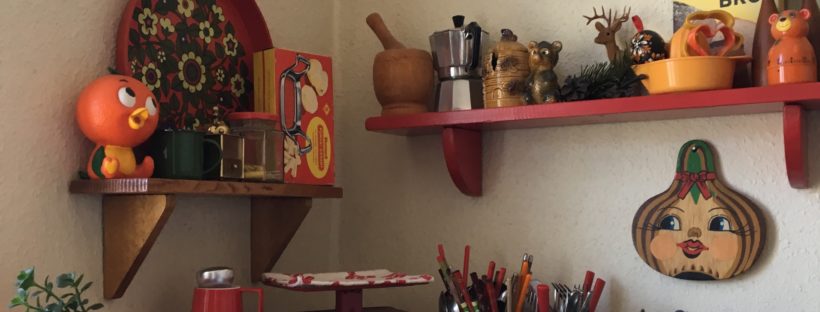Elke K.W. is one of the most intrinsically creative people I have ever met. She has a magical way with words, spinning wordplay into every few sentences of conversation. And she perceives all of life’s tasks big and small to be an opportunity for beauty and inventiveness. Nothing need be conventional in her world. That is what allures people to Elke. With tattooing, she brings sly humor to her tattoo designs, with visual puns and clever thematic twists. When drumming, she fills every beat and half beat and quarter beat with constant surprises; she does not waste the space, and the drums thump forward like lead guitar riffs instead of predictable old rhythms. I have had the pleasure of being Elke’s friend for nearly 20 years. We met in Baltimore and instantly bonded over record collecting and show-going and thrift store shopping. We lived together for several years and constantly shared music. These were good days.
In June, I had the privilege of visiting her at her home in Berlin. I was particularly interested to revisit my memory of the recipe box she kept full of index cards, each with a mixtape playlist that she had made for someone else documented and filed away. This interview picks up en media res, with Elke explaining why she has habitually kept documents of each mixtape made.
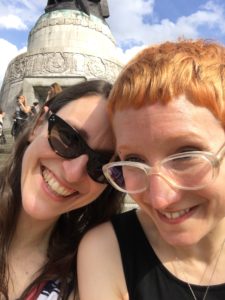
sarah and elke in berlin june 2017
Elke: Sometimes it comes about because I make a thing just so I can proofread it, proof-listen to it, and hear if it works. And then sometimes you discover flaws. Or with CDs nowadays too, sometimes what I want won’t fit on a single disc and then I’ll have to do some rearranging. Or I’ll decide at the last minute that I want something other than what I had, and then I’ll save my initial rough draft copy.
Sarah: For what?
Elke: For my own listening pleasure because obviously I like what I put on there. [laughter] And also–I know definitely in your case– I like to listen at the same time to something that I think that the other person could be listening to, especially when distance is involved. I remember driving down to wherever you were living to deliver “Something Awesome Really Already Happened” [laughter] –the original copy. And I remember then also listening to it later myself back in Baltimore.
And, it’s cool to think that the person could be experiencing these songs that you know intimately, that they could be discovering them for the first time on your mix and then you’re listening to the mix. Because it’s like a whole experience, the sequence. I mean, plus for practical reasons you wanna check and make sure that the flow is right and that it’s a winner.
Sarah: I remember every time you made a mix for somebody, you would write down the song titles and put them in a recipe box.
Elke: I think it’s in the other room.
Sarah: Yes, so what was that for?
Elke: Well, for one, for just purely practical reasons so that I would have a record and wouldn’t repeat songs. Because I was desperate not to repeat songs because that would be very uncool, I think. And it would prove that your skills were lacking in mix tape making. So it was supposed to prevent that. That was the chief reason.
And we had no computers, so everything had to be written down. I still don’t have a database of these things other than my lil’ box.
Sarah: So how much have you consulted the recipe box of index cards of mix tape listings?
Elke: Let me get this here box. Hold on. Wait, how much have I consulted it in future mixes? I used to consult them every time. You know, like you definitely don’t wanna repeat songs, and if you’re making frequent mix tapes, then it’s possible, because you’re into the same stuff. And if you’re making them for multiple people you don’t want to get confused because you’re probably gonna put your fave hits from that time period on multiple tapes, of course. That’s normal.
And also then I would consult other people’s mixes. Especially like this. [The Pixies play in the background.] This was a classic closer, you know, the cover of the Lady in the Radiator Song from The Pixies. This was always perfect for a closer because it sounds like the end of all time or something. [laughter] And also it’s short and so it’s a good thing to tack on to the end and leave them with a quick lil’ jolt. But because I, during this period, was doing that a lot, I had to make sure I didn’t do it on two tapes for one person.
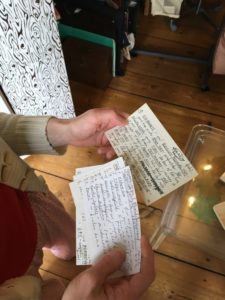
elke holds some examples of documents of mix tape playlists
It was good to consult, because I kept a running library of these little, tiny songs that I liked to put at the end of things in the minute or two that you would have left on the end, so you wouldn’t waste tape. I would often forget my library of tunes and have to consult. And then you always have a record of what works at the end. I probably used In Heaven by The Pixies more than maybe I should have. I should have come up with something else. But there’s that Sinking Body track I believe winds up on the end of quite a few.
Sarah: What is Sinking Body?
Elke: Sinking Body was that – somehow they’re Men’s Recovery Project-adjacent. I think that’s how I learned about them was because Men’s Recovery Project had a record that was a split with Sinking Body and they were on Vermiform. But I think it was just one dude. I don’t know much about them, their history at all, but they had this beautiful track that was on a 10 inch, and I can picture it. I think here I acquired maybe a YouTube, an MP3 version of it because I didn’t otherwise have it anymore because I have no means to play vinyl here sadly. But I do have it again and I’ve returned it to its mix-making glory. [laughter] And I think it’s quite short and quite repetitive, but it’s awesome. It’s one of my favorite tunes of all time.
But I would always put it at the end either of one side or the other – because you could even break it down to songs that were good for the end of side A, you weren’t ready to say goodbye, but it was like a good closure to the first half of something.
Should I put on Something Awesome Really Already Happened?
Sarah: Yes.
Elke: It’s not a tape, but I have this one.
Sarah: But it – was it a tape at some point? It was a mix CD.
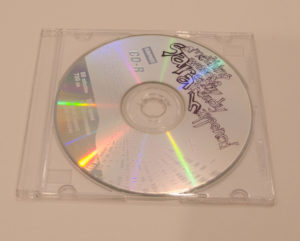
Elke: No, it was always a mix CD because this was into the era – we can look at when it was. Check it out, it’s the most recent. I think it might be the most recent one that I made for you. Which is 7-7-07, this is ten years ago. Have I not made you a mix in ten years?
Sarah: I think that sounds right.
Elke: That’s fucked up.
Sarah: Yeah, it is. [laughter]
Elke: I think I lost – to be honest I think I lost my –
Sarah: Joie de mix-making?
Elke: Oh, yeah. Maybe a little bit of that, but also in relation specifically to you I might have thought that I wasn’t gonna be showing you anything you didn’t already know.
Sarah: Oh, well that wouldn’t have mattered to me, even if true, which wouldn’t be true.
[Elke and I start looking at the tape case for the mix tape she made me around 1999.]Elke: This is interesting paper.
Sarah: So this case reminds me that when I mentioned this project to you, you said something about the artwork on tapes. And this is quite elaborate artwork because you cut out images from the instruction manual that came with this lamp that you called “the testicle.”
Elke: On there it looks like a hairy potato, but it could be a hairy testicle. It looks like if a testicle was mounted in a museum exhibit to remind us what testicles looked like. [laughter] Just sit it on a little platform: “Behold, the testicle. Once necessary.”
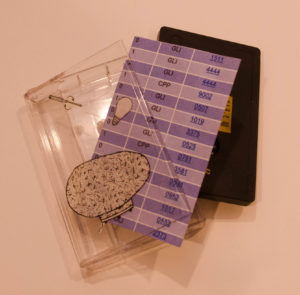
Sarah: [laughter] Well, in any case, it illuminated my evenings in Baltimore. And you turned it into a tape case.
Elke: But I don’t know what else is going on there. And there’s no title and there’s no track listing, for which both things I apologize because they’re signs of – probably not laziness but – well, maybe a little bit of laziness. That happens to be something that I have noticed winds up being the first thing to be absent even in the ages of making mix CDs, maybe especially then– because you don’t have to keep track, yourself, while you’re making it.
That was the thing. I think these were the final – like I think I would first do it by–I’d have like a worksheet, just a scrap of paper, because you would make mistakes. You’d have to work it out. And the most painful thing is that you got to the end of the 45 minutes and things hadn’t worked out the way you wanted them to. And I had to always write down times and add times up.
Sarah: Were you ever making mix tapes from tapes?
Elke: Very occasionally. Yeah, and also vinyl and other people’s mix tapes. That’s like what we were talking about earlier. I remember –I definitely took single, individual tracks that I really liked from other people’s mix tapes– I wasn’t into the overall musician or band enough to invest in a whole record of theirs, but I just liked particular tracks and would then subsequently pass them onto other people.
I remember [an ex-boyfriend] made me this mix tape with Roxy Music mostly – which was great – but then it started with this mysterious track that I couldn’t identify. I was obsessed with the song. It starts out too fast and then slows down. And I’ve since realized – well I’ve figured out, this was before I knew the Magnetic Fields actually – or maybe I knew the Magnetic Fields only when Susan Anway was singing.
And then this was Stephen Merritt singing a Magnetic Fields song called I Don’t Believe You and I was obsessed with this song. And plus it was appropriate for the relationship that I had with the boyfriend anyway. It was ironic that he had given me this song. But then I figured out eventually who it was, and it was on this 7 inch, which I think I did eventually acquire, but it also proved elusive somehow, the 7 inch, by the time I worked out what it was.
I’m not sure if I ever really got the record, but because I didn’t have the record for a long time, I don’t know if I even could credit it on mixes when I would put it on mixes. And I’ve recently acquired it again in digital form from the Internet and put it on new mixes.
Sarah: Wow, it persists.
Elke: But I realized that the 7-inch that it’s from really has this flaw, or whatever you want to call it. The version of it on YouTube also has this little, not hiccup, but it’s a second where his voice sounds chipmunk-y because it’s playing too fast. But it’s not just because the person on YouTube played the record at the wrong speed initially. I think it is recorded that way; it’s a recording thing.
Sarah: On purpose you think?
Elke: I don’t know. We would have to consult with Stephen Merritt. [laughter] But –yeah, I don’t know. But I really liked that song. And I discovered recently I still really like that song. He had made me this mix tape and at the time – because he lived in D.C. and I had the old [Dodge] Dart and the “Take-a-long” [tape player] and I would listen to that tape on the Take-a-long while driving, either going to or coming back from DC. I just remember it being summertime and at night and I associate those with the Roxy Music.
And it all sounded like it was from 100 years ago because it was on a tape, on a cassette tape. It was recorded from, in his case most definitely vinyl, because he was pretty devoted, I think, to having things in their original form. But it was somehow the perfect, I don’t know, scenario for that music, the Take-a-long. But, you know, wait, what question were we addressing?
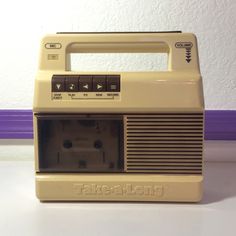
an image of the same type of “take-a-long” that elke played in her car in 1990s

dodge swinger dart much like elke’s old car
Sarah: Artwork.
Elke: But you did also ask about taking tunes from other tapes. Oh, yeah. I never had a lot of tapes. Like you had an extensive – you had the most admirable collection of like Dischord and other punk rock stuff on cassette, which I thought was amazing. Whereas I – the first music I ever acquired was on cassette, but it was Sinead O’Connor, The Lion and the Cobra.
Sarah: There’s no shame in that.
Elke: And also a couple of early, early mind you, U2 records on tape because my sister was obsessed with U2. And I stand by those, like October, for one.
Sarah: I think actually, if you would consult your recipe box, you would find that you put a lot of U2, October-era U2, on tapes for me.
Elke: Did I really?
Sarah: I’m pretty sure.
Elke: And I also had this single that was super cool, Stories for Boys.
Sarah: Like around ’99, I think. There was a lot of U2 listening.
Elke: But I don’t have the right dates for these then. I wonder if I missed a few. It’s possible I did – which would pain me. But I know I’ve missed some mix CDs that I’ve made for people because then it got much easier. You could make them much faster and if you weren’t being diligent about writing down what you’re doing– the thing with tapes, there was no readout of what was happening anywhere unless you wrote it down. Which is something I’ve forgotten about, but that’s pretty crucial and that’s really why things started to get written down.
And when I was making them, I would be inspired by one song to put another song on and it’d be like, “Oh, I have to write that down,” or I would forget. So I’d have this jumbled list of things– like of ingredients that should be on there. But then they’d have to be sorted and organized according to time. And also, you don’t wanna put like a block of really long songs that would get somehow exhausting for the listener. You gotta break it up, but then you gotta save your little bits and pieces to tack onto the end. And you gotta always have the right intro tunes, also.
Sarah: Oh, first song is critical. You have to hook them.
Elke: Yeah, the first song’s critical, but also side B’s first song, almost, like in a secondary position of criticalness.
Sarah: Yeah, you have to say, “Stay with me.” [laughter]
Elke: Yeah, exactly. “Like here we go again. How’s this gonna end?” [laughter] We don’t know.
Sarah: So how many different people do you have mix tape listings for in here?
Elke: Okay, this is – well, let’s see what I don’t have. Nobody starts with B, never made a mix for anybody whose name starts with B.
Sarah: We need to work on that. I have some friends with B’s.
Elke: Really?
Sarah: Yeah.
Elke: But do I? [laughter] Not very many. Okay, no D’s, surprising. Lots of E’s it seems. I think that’s because of certain Eriks. Yeah, it’s mostly Erik. And there’s one for Ezio, poor Ezio. And one for Enno. One for F.
You, by the way, take up the vast majority of S.
Sarah: I should.
Elke: Yeah, you really do. There’s only a few more in here. I made mix tapes for myself as well. And some of those are in here as well.
Sarah: Do tell… Under E?
Elke: I don’t know where I found them. I think they might be under like M for myself. [laughter] Oh, I think they’re at the very beginning here. Sometimes I think I got a winner and I like to listen to it myself.
[Elke continues to look at the mix tape lists and talk about the people for whom she made tapes. She finds a playlist for a tape for an old high school friend.]Elke: This one I remember, I actually had a mix tape label for myself called More Nakeder Records and this is one of those. I remember because I made elaborate cases for those. But then I think that’s why it petered out. And this one is called Guided by Couscous and I think that’s because I put a lot of Guided by Voices on it and –it was during a time when we would always get the Fantastic Foods couscous box mix, as if couscous is a challenging thing to make. But I think we didn’t realize that you could just buy the couscous by itself and do the same thing. We were eating a lot of couscous at the time because it’s a pleasing thing to eat and easy to make.
Let’s see what else we got here. And I know this was another More Nakeder Records release called the Darjeeling Feeling. But I remember the case to that had a carefully reconstructed, but miniature, teacup stain on it. It couldn’t be a full-size teacup stain because it wouldn’t fit appropriately on the tape case. But I remember staining the paper that I was using somehow – using some object that had a smaller circular bottom on it. There was somehow a small spoon involved too, but I think it was just like – I found an image of a spoon and cut it out and put that next to the stain. And that one has a date. I guess I actually wrote the day that I made these things, which in this case was 15 of August 1995.
Sarah: What grade would you have been in starting fall of ’95?
Elke: Actually I graduated in ’95 so I guess this was right after high school.
Sarah: Maybe that period of time was making you wanna make a lot of mix tapes.
Elke: Yeah, well definitely. Because I feel like that was the time when one has confidence in their music taste. And I know I was constantly discovering stuff that I thought was the awesomest. It was like a period of much discovery.
Sarah: How does that compare to now?
Elke: Oh, I have much less, I guess, confidence in what I like. Or there’s much less discovery. But I mean, that, I think, is a natural course. But there’s more rediscovery of stuff– like looking at these things made me realize how awesome this music is. And I guess that’s helpful because I have this problem with not liking very much stuff, I feel like.
[Elke pulls out another index card.]I remember this had elaborate packaging too. It was called Main Course. I’m missing the other pieces because it was a three CD set and there was a main course and that was the only one that I saved for myself I guess.
I only have a vague recollection of maybe there was some napkin involved. But there was a main course and a dessert definitely, and an appetizer. But I only have the main course now.
Sarah: So what do you think, predominantly, your motivations have been most of the time for making mixes for people?
Elke: Well, this is not the predominant reason. I have to admit that definitely sometimes it’s to communicate stuff.

elke checks telephone
Sarah: Like what?
Elke: That is, something you’re having difficulty otherwise communicating. This has happened maybe even recently. I know it wasn’t a mix tape, it was a mix CD where there was no response to the message. [laughter]
Sarah: So you gave someone a mix CD that you felt was communicating something very specific and the person –
Elke: Didn’t really react almost at all. I mean, I think they said thank you [laughter], but I didn’t get acknowledgement until later. Then they, of their own accord, remarked on [the mix]– and then I knew that they had actually listened to it. But, yeah. I think sometimes you’re trying to say it with songs. –Do you think I made those when you were still living in the house?
Sarah: Well, these tapes are from when I moved.
Elke: Because we probably wouldn’t have really made each other tapes while we were living together.
Sarah: Yeah, I don’t think so.
Elke: Because we spent so much time together not only in the house, but also in the car listening to music. And mix tapes were really good for being in the car. That’s probably where I listened mostly to mix tapes. Although I probably received my first mix tapes before I could drive, I think. But then I definitely started driving in cars that had tape players and that was the way that I listened to music, including people’s mixes.
I have this one mix that I also have a copy for myself because I was really in to all the tracks that I put on it and it was also good to run to, I think. But I made it specifically for More Dogs when they were gonna go on tour. So it was for all those dudes, and I made it specifically for them to listen to while on tour in a van. And it was just called…[Elke consults the index cards]… Boyfriend’s Road Mixture, here we go. But so, I remember doing that. But I would often think – I think for other just general use mix tapes that I think I thought of them being played predominantly in cars somehow.
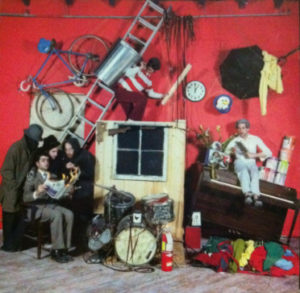
cover of first album by baltimore band more dogs
Sarah: When you were making them, you were thinking about how this would be played in a car?
Elke: Maybe. That probably wasn’t super conscious I guess, but now that I think about it, that was probably because that’s how I listened to them most, I think.
I think that’s what I would think about if I thought about how you would use a mix tape. I would imagine it would be in a car, in your station wagon. Because I think that’s how I’d experienced – even like driving around with other people, playing tapes. And that, I think, has happened before, maybe with us, where you’ve played a tape that I made you in a car while I was sitting there– and that always makes me nervous – because it is like a communication thing and you’re like, “How are they gonna react?” [laughter] Even when it’s not communicating a specific thing other than, “You’re my pal” and “Check this out.”
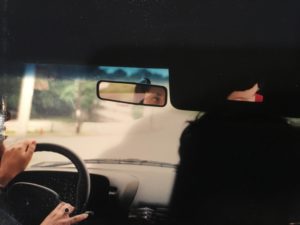
sarah and elke in station wagon 1998
Because it’s basically saying check out this stuff that I feel speaks for me and this music that is obviously stuff I like so it has something to do with me. So it is a bit of a risk of rejection, because if they reject the music you like then they’re rejecting a little part of you! [laughter] Even though it’s super silly to think that someone’s gonna like every single thing. And you wouldn’t want them to like every single thing because then there would be less room for other stuff that they could turn you on to that they like.
And of course you want them to like the mixes that you made them more than other people’s mixes. [laughter]
We were talking about purposes of making them, right? I don’t know how conscious this is either, but it’s like a snapshot of yourself and what you’re listening to at that time, and you wanna get that down for this other person too that your life is being shared with– especially if they’re away. That’s the thing. Like I find that it’s usually people that are either going away or are already at a distance, so it’s good to have snapshots of different periods.
Sarah: So one thing I definitely wanted to hit on in this interview was the artwork piece because I think I’ve gotten the most elaborate tape case covers from you.
Elke: Really?
Sarah: Yeah.
Elke: That’s cool. Although I’m sure I dropped the ball a few times. But that was a point of pride, I guess.
Sarah: How so?
Elke: Well, because I think the packaging maybe is not half the thing, but it’s still a big percentage of the potential value. And I guess I also like to make things. And usually a tape, I think, has sort of a conceptual thing. I mean, some of the earlier ones obviously have more to do with things going on between the person I’m making it for and me – like the couscous, things that were being eaten or consumed otherwise.
But definitely already with the tapes, I started this thing where it was very important that I have a title, and the title would be a lyric, a key lyric from one of the tracks. And choosing the title sort of set the tone for the visuals also, sometimes. Although in the case of these things, it was obviously like a phase where I wanted to take elements that I knew you would recognize– the little guy here, is from a Hanahreum package, something we would have gotten at the Hanahreum [Asian supermarket].
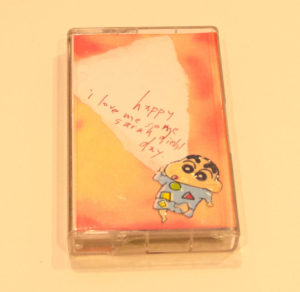
Sarah: Awww. To eat together. Aww.
Elke: Yeah, I’m pretty damn sure. And then I guess just – I mean, I guess I’ve always liked to make things from [other materials]– and that’s how I make CD cases now. But if I think about it, it’s from like cheap advertising paraphernalia collaged together. And I think I had those Rotex things. I love those Rotex labels.
Sarah: Rotex?
Elke: Remember that tape? I call it that, but it’s not the generic name. It’s just that the first one I ever had, I’d borrowed permanently from my father. And it was called a Rotex, the thing where you feed tape into it.
Sarah: Oh, the traditional label makers.
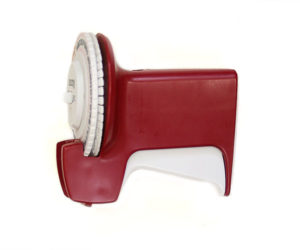
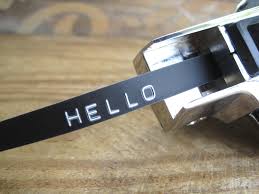
Elke: Yes. And when I worked at the Ross Dress for Less, I acquired two that had an interchangeable disk– maybe this was originally meant to do that, too– where you can pop in this other disk and one of them does cursive and one of them does vertical writing.
Sarah: Whoa.
Elke: And now I have some German ones that have the little umlaut letters.
Sarah: Neat.
Elke: Yeah. I kind of collected these.
We belong to the generation of people who had objects relating to music and collected these objects. And they were obviously a part of the music that they would also have sort of their own value and worth. And I think I just transferred that to making tapes.
Because it’s also your product, you know? The mix is your product even if it’s made out of other people’s music. So then you want there to be a visual product that reflects the “you” part of the whole thing. And I think that was the idea. But then it can get out of hand. And I think that’s why I started to slip a little bit in the visual thing because if you have set such high expectations of the packaging, and it’s for somebody’s birthday or something, you’re not able to produce in time– or if it winds up holding up your production of the mix itself, which I’ve had happen, then it gets pretty ridiculous. The person never gets the mix.
Sarah: [laughter] Because you were laboring.
Elke: Because you still didn’t make the packaging. It’s been a long time where my packaging pride had to significantly be diminished because I was just failing. [chuckles] And I’ve even given people mixes with no track listings and no information whatsoever. Which I also think can be interesting because then they really are going in blind. And maybe they recognize a few old friends or they’re completely bewildered [laughter] by new things. But it always pains me a little bit if I don’t have time to produce. It seems cheap to just hand over just the music I guess is what I’m saying.
Some of the first mix tapes I ever got were from a friend when he worked at Art Things and he also worked at Toad Music in Severna Park, MD, which is probably the first cool record store that I ever had any contact with or exposure to. And I started collecting records from specific labels that the people that were there turned me on to, including this friend. He also worked at Art Things, which was this art supply store in Annapolis. So he had a lot of access to various visual crap that could be assembled to make cool packaging.
And he made pretty professional, but specific to him and his tastes, looking tape cases. They were elaborate and admirable. I think that sort of set a standard as to what defined a proper packaging for a mix tape. And I think somewhere I definitely still have his mixes, but maybe not with me here. They were pretty elaborate and so that set the benchmark that you had to reach. But it can get ridiculous. And if it gets ridiculous enough that you fail to make the mix at all because you’re hung up on the packaging, then you have failed overall. [laughter]
But, it’s also fun. It’s very fun. And I think that’s one of the things that–when I have ideas that come as a complete notion—or the times that I feel the best about something I’m making, I can remember, is when it’s like I got a complete packaging idea, and it all came together.
Sarah: Do you have another outlet now to use that same kind of creativity?
Elke: Oh, sure. Yeah, I mean my job has to be. I don’t always get that same sense. There’s only a
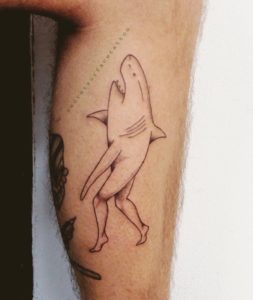
shark pin-up person: recent tattoo drawn and tattooed by elke
few times that I can think of where the whole package comes together. I just remember making mixes late at night and being giddily excited and working on the package at the same time as I was making the tape, too, because you had to wait. That was the other thing about tapes that’s pretty crucial. So you had to wait for the song to play and you had to listen to every song to its completion.
That’s a really big difference between the CD era because sometimes – nowadays when I do the CD thing I’ll just listen to bits. I’ll listen to the beginning and the end of songs to make sure that there’s an acceptable flow, according to me. [chuckles] But yeah, the tape making was really a much more potentially grueling process. You could be working on the packaging while songs were playing out, especially if you included longer-winded jams, you had more time. But then there was a lot of running back and forth.
And then you also had to chronicle what you were doing and that’s how these guys came about. [Elke points to the index cards.] Yeah, that is another interesting facet that I’d forgotten about. It’s kind of amazing that we did that as much as we did, that we made so many tapes. I wonder how many hours are involved- because it’s way more of a time investment. And if you screw it up you’d have to go back over it.
But it’s weird that this one doesn’t have the things punched out because I remember there was also a satisfaction when you did have it done. Then you would remove the ability to tape over it unless the person was really determined and put tape over it, but that would be sad.
Sarah: I forgot about that ‘til this morning for some reason, that it was like you’re controlling what the recipient will be able to do with this thing you’re giving them. “I have made this permanent.”
Elke: Yeah, but I know I did that and I used to even save them. For a while I saved those things.
Sarah: The little –
Elke: The little tabs.
Sarah: –punch out tabs?
Elke: Yeah. I just remembered that. I don’t think I still have them, that would be really weird. But I didn’t punch them out of [this tape I made for you]. Maybe I thought you’d wanna use it to tape over.
Sarah: Oh, yeah, they’re there.
Elke: Yeah, I didn’t do it.
Sarah: Maybe you trusted me.
Elke: Either that or I thought maybe she’ll hate it so much she wants to use it as a blank tape. Yeah, I think that was a short-lived –
Sarah: Collection?
Elke: And admittedly pretty stupid thing to be collecting. [laughter] But you can see that I saved all of the blank [tape label] stickers in case I needed some more. Just a few more.
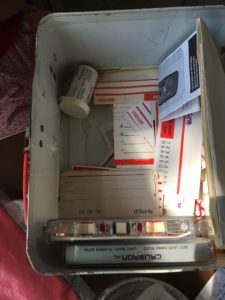
Sarah: So this whole lunch box is mix tape materials?
Elke: This used to be my “technology tin.” I don’t know. These are supposed to clean your cassette heads. A couple different varieties.
What else is in here? Instructions– I had a little voice recorder that was digital which was such a pain in the ass. Here’s a record player needle. Weird. It says “OLD.” I guess it’s an old record player needle. [laughter] You’re making a really funny face. I have an old, used record player needle in case anybody wants one. [laughter] Next flea market I’ll have to put that one out there so someone can pick that up. 99 cents.
Then I have – there could be some little secrets in here. Oh, yeah, look. I don’t know what this was for but I must have had some high hopes of making some packaging, elaborately cut out. But, yeah, weird stuff in here. This was the More Nakeder – look see, it’s the More Nakeder official–-
Sarah: Oh, this is your record label box. [laughter]
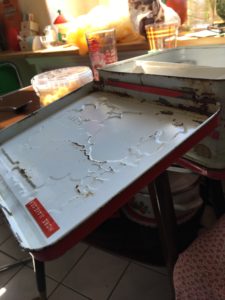
Elke: Yes, my mix tape label box. [laughter] Yeah, it does consist mostly of unused labels for cassettes.
Elke K.W. is a multi-media artist who is currently focused on making tattoos and illustrations in Berlin, where she lives and works. http://secretsurfacetattoo.tumblr.com/

elke
